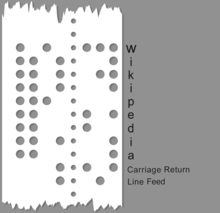
1010111.Character encoding is the process of assigning numbers to graphical characters, especially the written characters of human language, allowing them to be stored, transmitted, and transformed using computers.[1] The numerical values that make up a character encoding are known as code points and collectively comprise a code space, a code page, or character map.
Early character codes associated with the optical or electrical telegraph could only represent a subset of the characters used in written languages, sometimes restricted to upper case letters, numerals and some punctuation only. The advent of digital computer systems allows more elaborate encodings codes (such as Unicode) to support hundreds of written languages.[disputed – discuss]
The most popular character encoding on the World Wide Web is UTF-8, which is used in 98.2% of surveyed web sites, as of May 2024.[2] In application programs and operating system tasks, both UTF-8 and UTF-16 are popular options.[3]
- ^ "Character Encoding Definition". The Tech Terms Dictionary. 24 September 2010.
- ^ "Usage Survey of Character Encodings broken down by Ranking". W3Techs. Retrieved 29 April 2024.
- ^ "Charset". Android Developers. Retrieved 2 January 2021.
Android note: The Android platform default is always UTF-8.